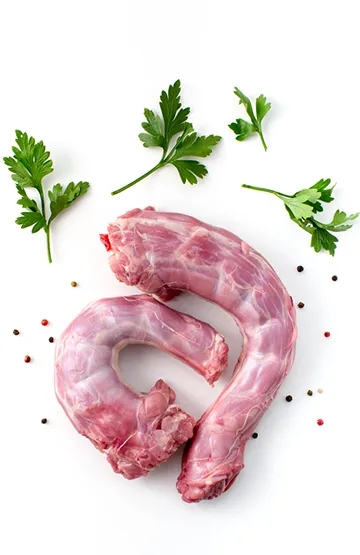
Can Dogs Eat Turkey Necks? The answer largely depends on how they are prepared. Raw turkey necks can be a nutritious and enjoyable chew for dogs, often included in raw feeding diets or given as an occasional treat. However, cooked turkey necks should always be avoided, as cooking makes the bones brittle, increasing the risk of splintering, choking, or internal injuries.
If your dog has never had raw turkey necks before—especially if they are older—it’s best to introduce them gradually. Sudden dietary changes can cause digestive upset, particularly in senior dogs who may have a more sensitive stomach. If you decide to offer a turkey neck, start with a small portion and monitor your dog’s reaction. Their tolerance to new foods, especially raw options, varies from dog to dog.
As with any new food, consulting your veterinarian before adding turkey necks to your dog’s diet is always a good idea.
Can Dogs Eat Turkey Necks?
Yes, dogs can eat raw turkey necks, but cooked turkey necks should be avoided due to safety concerns.
Raw turkey necks can be a healthy addition to a dog’s diet when fed in moderation. They are rich in protein, glucosamine, and chondroitin, which support joint health, and their natural texture helps promote dental hygiene by reducing plaque buildup. Many raw-fed dogs enjoy turkey necks as a nutritious chew treat.
However, cooked turkey necks pose a serious risk. Cooking makes the bones brittle, increasing the likelihood of splintering. These sharp fragments can cause choking, internal injuries, or digestive blockages, which may require emergency veterinary care.
Additionally, not all dogs tolerate dietary changes well. If your dog has never had raw turkey necks before—especially if they are older or have a sensitive stomach—introduce them slowly and in small portions to prevent digestive upset.
Before adding turkey necks to your dog’s diet, consult with your veterinarian to ensure they are a safe and appropriate choice for your pet’s health needs.
Can Dogs Eat Turkey Neck Bone?

Dogs can eat raw turkey neck bones, but cooked turkey neck bones should never be given due to serious health risks.
Raw turkey neck bones are generally safe for dogs when fed appropriately. They are softer and more flexible than weight-bearing bones, making them easier to chew and digest. Raw bones also provide essential nutrients like calcium and phosphorus, which support bone health, and their natural texture helps clean teeth by reducing plaque buildup.
However, cooked turkey neck bones are extremely dangerous. Cooking makes the bones brittle, increasing the risk of splintering into sharp fragments. These fragments can cause choking, puncture the digestive tract, or lead to intestinal blockages—potentially requiring emergency surgery.
Additionally, some dogs may struggle to digest raw bones, especially if they have a sensitive stomach or are not accustomed to raw feeding. To minimize risks, introduce raw turkey neck bones gradually, supervise your dog while they chew, and consult your veterinarian before adding them to their diet.
Brief Overview of Common Concerns Regarding Feeding Dogs Turkey Neck
Feeding turkey necks to dogs, while beneficial, comes with its share of concerns that pet owners should be aware of. Here are a few key issues:
- Choking Hazard: One of the primary worries is the risk of choking, especially for small dogs or those that tend to gulp their food without chewing properly. It’s crucial to choose the size of the turkey neck appropriately and supervise your dog while they eat.
- Bone Splintering: Cooked bones, including turkey necks, can splinter and cause internal injuries or obstructions. This is why raw or dehydrated turkey necks are generally recommended for dogs.
- Digestive Issues: Some dogs might have sensitive stomachs or specific dietary restrictions. Introducing turkey necks too quickly or in too large quantities could lead to digestive upset.
- Nutritional Imbalance: While turkey necks are nutritious, relying on them too heavily can lead to an unbalanced diet. It’s important to ensure they are part of a well-rounded diet.
Benefits of Turkey Necks for Dogs
Turkey necks offer a variety of benefits for dogs, making them a popular choice among pet owners who are keen on providing their furry friends with a balanced and nutritious diet. Here’s a closer look at the advantages of incorporating turkey necks into your dog’s meal plan.
Nutritional Benefits
- Protein: Turkey necks are a great source of high-quality protein, essential for building and repairing muscles and other tissues in dogs. Protein is a crucial component of a dog’s diet, supporting overall growth and maintaining a healthy immune system.
- Calcium and Phosphorous: These minerals found in turkey necks are vital for the development and maintenance of strong bones and teeth. Calcium and phosphorous play a significant role in ensuring proper skeletal health, making turkey necks particularly beneficial for growing puppies and older dogs who may be more prone to bone-related issues.
- Glucosamine and Chondroitin: Known for their role in maintaining joint health, these compounds naturally present in turkey necks can help support joint mobility and reduce the risk of degenerative joint diseases, especially in senior dogs or breeds predisposed to such conditions.
Dental Health Advantages
Chewing on raw turkey necks provides a natural way for dogs to clean their teeth. The action of gnawing helps to:
- Remove plaque and tartar buildup, reducing the risk of gum disease and bad breath.
- Strengthen the jaw muscles, contributing to overall dental and oral health.
- Offer a satisfying chewing experience, which can help alleviate boredom and reduce destructive chewing behaviors.
Role in a Raw Diet or as a Treat
- As part of a Raw Diet: Turkey necks can be a valuable component of a raw food diet for dogs, providing essential nutrients in a form that’s close to their natural dietary patterns. When balanced with other food sources, turkey necks can help mimic the variety and nutritional profile of what dogs might eat in the wild.
- As a Treat: Even if you are not feeding your dog a raw diet, turkey necks can serve as a nutritious and enjoyable treat. They are especially useful for special occasions or training rewards, offering a healthier alternative to processed treats.
Incorporating turkey necks into your dog’s diet can provide numerous health benefits, including improved dental hygiene and increased nutritional intake. They can play an important role in raw diets as well as occasional treats, helping your dog live a happy, healthy life. However, to ensure that these benefits are enjoyed safely, turkey necks should be introduced gradually and under supervision, particularly for dogs who are unfamiliar with raw bones.
How to Safely Feed Your Dog Turkey Necks
Feeding your dog turkey neck can be a healthy addition to their diet when done safely and thoughtfully. Here’s how to ensure your furry friend enjoys their treat without any mishaps.
Selecting the Right Size and Type of Turkey Neck
- Size Matters: Choose a turkey neck that matches your dog’s size and chewing capability. Larger breeds can handle whole turkey necks, while smaller breeds might do better with turkey necks cut into smaller pieces.
- Type of Turkey Neck: Opt for raw turkey necks whenever possible, as they are less likely to splinter than cooked ones and retain more nutritional value. Ensure the turkey necks are sourced from reputable suppliers to minimize the risk of contamination.
Preparation Methods
- Raw vs. Cooked: It’s generally recommended to feed raw turkey necks because cooking can cause the bones to become brittle and prone to splintering, which can be dangerous. If you’re concerned about bacteria, you can briefly blanch the turkey necks in boiling water to kill surface bacteria without cooking the bones thoroughly.
- Whole vs. Chopped: Whether to feed the turkey neck whole or chopped depends on your dog’s size and eating habits. Smaller dogs or those prone to gulping their food might benefit from chopped pieces to encourage slower eating and reduce the risk of choking.
Recommended Feeding Frequency and Portion Sizes
- Feeding Frequency: Turkey necks should not replace your dog’s regular diet but rather complement it. They can be fed as a treat or part of a meal a few times a week, depending on your dog’s dietary needs and overall health.
- Portion Sizes: The portion size depends on your dog’s size, age, and activity level. A good rule of thumb is that treats and extras like turkey necks should make up no more than 10% of your dog’s total daily calorie intake. For example, a large dog might handle a whole turkey neck, while a small dog might only need a quarter or half.
Alternatives to Turkey Necks
While turkey necks can be a nutritious and dentally beneficial treat for many dogs, they may not be appropriate for all dogs due to dietary restrictions, size, or health concerns. Fortunately, there are several safe and healthy alternatives that offer comparable benefits.
Other Safe Bones and Chews for Dental Health
- Raw Bones: Other raw bones, such as beef marrow bones or lamb necks, can also be good for your dog’s dental health. It’s essential to choose bones appropriate to your dog’s size and to always supervise them to prevent choking or splintering risks.
- Dental Chews: There are many high-quality dental chews available that are designed to help reduce plaque and tartar buildup. Look for products approved by veterinary dental organizations for efficacy and safety.
- Vegetable Chews: For dogs with specific dietary needs, large pieces of raw carrots or specially designed vegetable-based chews can provide a safe alternative for dental health without the risks associated with bones.
Nutritional Alternatives for Dogs with Dietary Restrictions
- Fish: Cooked, boneless fish like salmon or sardines can be excellent sources of omega-3 fatty acids, protein, and other vital nutrients for dogs with dietary restrictions.
- Organ Meats: Organ meats from various animals can be a nutrient-dense alternative, offering vitamins, minerals, and protein. These should be fed in moderation as part of a balanced diet.
- Commercially Prepared Raw Diets: For owners interested in the benefits of raw feeding but concerned about balancing nutrition or handling raw meat, commercially prepared raw diets can be a convenient alternative. These diets are formulated to be complete and balanced, mimicking the nutritional profile of a natural carnivorous diet.
Conclusion
Turkey necks can be a nutritious and enjoyable addition to your dog’s diet, providing numerous benefits such as improved dental health, joint support, and an adequate supply of protein, calcium, and other essential nutrients. However, it is critical to approach the inclusion of turkey necks with awareness of the potential risks, such as choking hazards, and the importance of selecting raw bones over cooked bones to avoid splinters.
Before introducing turkey necks or any new food to your dog’s diet, always consult with a veterinarian. They can offer advice tailored to your dog’s specific health requirements, dietary restrictions, and overall well-being. By taking these precautions, you can help ensure that your dog has a safe and enjoyable experience with turkey necks, which will benefit their overall health and longevity.
FAQ.
Can Puppies Eat Turkey Necks?
Yes, puppies can eat turkey necks, but there are some important things to keep in mind. Turkey necks should be added to a puppy’s diet gradually and only when they are old enough to handle raw bones—usually around 12 weeks of age, but this can vary depending on the breed and size of the puppy. To avoid choking hazards, choose turkey necks that are the right size for the puppy and keep them under close supervision while eating. Puppies can benefit from the nutritional value and teething relief that chewing on turkey necks provides, but always consult with your veterinarian first to ensure it’s right for your puppy.
How Often Can I Give My Dog Turkey Necks?
Turkey necks can be a nutritious addition to your dog’s diet if consumed in moderation. In general, offering a turkey neck 1-2 times per week is sufficient for most dogs. However, this is subject to your dog’s size, dietary needs, and overall health. Turkey necks should supplement, rather than replace, a well-balanced diet, so make sure they make up a reasonable portion of your dog’s total food intake. Always monitor your dog’s reactions to new foods and adjust their diet accordingly.
Are There Any Dogs That Should Avoid Turkey Necks?
While many dogs can safely enjoy turkey necks, there are some cases where they might not be suitable:
- Dogs with Dental Issues: Dogs with weak teeth, dental disease, or those who have had dental surgery may find it challenging to chew on turkey necks safely.
- Dogs with Digestive Sensitivities: Some dogs may have sensitive stomachs or specific dietary restrictions that make raw bones unsuitable.
- Small Dogs and Puppies: Although puppies can eat turkey necks under supervision, very small dogs or young puppies may find them too challenging or risky due to their size. For these pets, it’s better to choose smaller, softer options.
- Dogs with Chewing Behavior Issues: Dogs that gulp their food without chewing properly are at a higher risk of choking on bones.
Always assess your dog’s individual health, dietary needs, and chewing habits before introducing turkey necks into their diet. Consulting with a veterinarian can provide personalized advice based on your dog’s specific health profile and nutritional requirements.
Related Posts:
- Can Dogs Eat Brazil Nuts? Risks & Safety Explained
- Can Dogs Eat Whole Wheat Bread? A Comprehensive Guide
- Can Dogs Eat Dandelions? Health Benefits of Dandelion Greens
- Can Dogs Eat French Fries? 5 Hidden Dangers You Need to Know!
- Can Dogs Eat Cooked Fish? Can Dogs Eat Raw Fish?
- Is Jasmine Rice Good for Dogs? Health Benefits Explained
- Can Dogs Eat Honeydew Melons? Benefits, Risks, and Safe Feeding Tips
- Can Dogs Eat Mussels? Benefits and Safe Prep Tips
- Can Dogs Eat Meatballs? Vet-Approved Tips and Nutrition Advice
- Can Dogs Eat Raw Fish? Risks, Benefits, and Safety Tips
- Can Dogs Eat Raspberries? Find Out the Truth About This Sweet Treat!
- Can Dogs Eat Hard-Boiled Eggs? Discover the Surprising Benefits!
- Can Dogs Eat Kale? Discover the Surprising Truth!
- Can Dogs Eat Radishes?
- Can Dogs Eat Pepperoni? Is Pepperoni Bad for Dogs? Here’s What You Need to Know
- Can Dogs Eat Dragon Fruit? Everything You Need to Know!
- Can Dogs Eat Whipped Cream? The Answer May Surprise You!
- Can My Dog Eat Grits? Safe Treat or Risky Choice?



